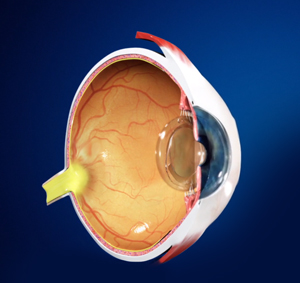
What is Intraocular Lens?
An intraocular lens or IOL is an artificial replacement for the natural lens in your eye. Cataracts cause the normally clear lens to become cloudy, adversely affecting your vision. An intraocular lens is used to replace the cloudy lens during cataract surgery. The IOL implant is placed just behind the pupil of the eye after the cataract is removed to improve vision in the eye.
Intraocular lenses are usually made of acrylic, silicone or other plastic materials and are coated with a special material to help protect the eye against harmful ultraviolet rays of the sun.
What are the Indications of Intraocular Lens?
Intraocular lens implants are recommended for correction or improvement of poor eyesight due to the presence of a cataract.
A cataract is an eye condition caused by age-related changes in the proteins that make up the lens of the eye. The lens helps focus light on the retinal layer at the back of the eye for clear vision. A cataract causes the lens to become cloudy so that objects appear blurry or brownish. When poor vision affects your quality of life, cataract removal and intraocular lens implants are recommended.
What are the Types of Intraocular Lens?
There are different types of intraocular lenses your doctor may recommend based on your existing vision and preference.
- Monofocal lenses provide clear vision at a specific distance, so they can be designed for either near vision or distance vision.
- Multifocal lens implants are designed so that parts of the lens provide a better focus for distance vision, while other parts provide a better focus for near vision.
- Accommodating intraocular lenses are flexible like the natural lens of the eye so they can be adjusted for clear vision at various distances.
- Toric intraocular lenses are recommended for people with cataracts who also have a condition called astigmatism, where the curvature of the eye is the abnormal affecting vision at all distances. This lens is designed to correct existing astigmatism.
What are the Pre-Operative Preparations for Intraocular Lens?
Before your eye surgery, your eye doctor will:
- Perform specific eye measurements and test your vision
- Select an appropriate implant for your condition
- Prescribe medicated eye drops to be used a few days before your surgery
- Instruct you to stop wearing contact lenses and taking certain medications several days prior to the surgery
How is Intraocular Lens Surgery performed?
An intraocular lens insertion surgery usually involves the following steps:
- You will have eye drops administered to numb the eye. You will also receive medication to help you relax.
- During the procedure, you may see some light but will usually feel nothing or only some slight pressure.
- A tiny cut or incision will be made through your cornea to reach the damaged lens.
- The cloudy lens will be cut and removed piece by piece.
- It is then replaced by the artificial intraocular lens.
- The incision heals naturally without the need for stitches.
You can return home within an hour of surgery. You should plan for someone to drive you home following the procedure.
Post-Operative Care for Intraocular Lens
You may be advised the following to aid in your recovery and to avoid complications.
- Keep your eye covered with a patch for several days following the procedure, even while sleeping.
- A small amount of fluid may ooze from the eye and you may feel an itchy sensation. Rubbing or pressing on the eye should be avoided.
- Take the medicated eye drops as prescribed by your doctor.
- Avoid exercise and heavy lifting until your doctor tells you it is safe to do so.
Complete healing may take around 8 weeks.
What are the Risks and Complications of Intraocular Lens?
Intraocular lens implant surgery is relatively safe. However, as with any surgery, it may be associated with certain risks. Swelling and redness are common and usually subsides. Rarely you may experience bleeding or infection.
Serious complications are rare but can include:
- The detachment of the retina
- Dislocation of the implant or
- Loss of vision
Related Topics
- General Eye Examination & Care
- Digital Retinal Photography
- Optical Coherence Tomography (OCT)
- Ocular Ultrasound
- Visual Field Testing
- Anti-VEGF Treatments
- Vitreoretinal Surgery
- Retinal Laser Therapy
- Pattern Laser Technology
- Cataract Surgery in People with Retinal Diseases
- Cataract Surgery in Diabetics
- Intraocular Lens (IOL)
- Premium Intraocular Lens (IOL)
- Photorefractive Keratectomy (PRK)
- Pediatric Ophthalmology
- Ultrasound Biomicroscopy
- Heidelberg Retinal Tomography

